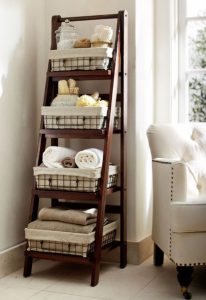When we were first married, my husband and I lived in a teeny-tiny apartment on a dead-end street with a slip of a kitchen and a bedroom with a door that was only able to open part-way once we installed the beds.
Cozy was an understatement.
Hailing from a sprawling childhood home on a picturesque, quarter of an acre property, it was quite the adjustment. And once our little princess arrived on the scene, ‘”we need to move” became my mantra.
But house hunting in Brooklyn, when we got down to it, was not quite the experience I’d imagined.
“Spacious living room” seemed to mean that it could fit a (small) sofa), and “large eat-in-kitchen” meant you might be able to get a few chairs in there. A “possible third bedroom” in one potential house was what I would have called a “closet.”
Toto, I most definitely was not in Kansas (er, Maryland) anymore.
Welcome to New York City, where the average home size is 1230 square feet (as per Property Shark) – as opposed to the national average of 2422 square feet (according to the U.S. Census Bureau).
It is within these smaller-than-average homes that many of us raise our families, using basements as playrooms and laundry rooms, and investing in bunk and trundle beds for the kids’ rooms in an attempt to maximize space.
And yet – and this may surprise those reading this from their McMansions in New Jersey – not only does it work, but there are actually perks to this type of living arrangement. While I no longer dwell in a shockingly small abode, I have come to learn over the years that families can not only be fine, but actually thrive in less than palatial accommodations.
Shared Space
With less space to spread out, families who live in smaller spaces tend to spend more time together by default. This means more opportunity for communication as you share the same sofa, do homework around the dining room table, or hang out in the kitchen. It’s during all these shared moments that real conversation happens – which is how families bond.
And if you think it’s ideal for each child to have his or her own bedroom, think again. There’s a certain amount of security that comes along with having a sibling in the same room. For a young child, that might mean not feeling lonely or isolated after they are tucked in for the night, and it may help them settle down and more be amenable to bedtime. As they grow, that may translate into shared whispered conversations and muffled giggles – moments that will shape their relationship as siblings in a very positive way, and moments they will cherish as adults when they reminisce about their childhood.
While you will likely have to field a certain amount of bickering that tends to arise when sharing close quarters (“don’t sit on my bed!”), there is something to be said for learning to negotiate and share on a regular basis.
Healthy and Happy
At some point, everyone needs a break from constant company, and when that happens, kids head for the door. Every parent knows the importance of fresh air for both physical and mental well-being. With less space indoors, your children will naturally gravitate outdoors – away from their electronics – growing up happier and healthier.
There’s plenty of talk these days about materialism and excess. Small space can take the focus off that simply because there’s just not enough room to accumulate so much stuff. There may be a fair amount of consideration before purchases are made as Mom and Dad think about whether there is enough room for the items in question. Sometimes that answer will be no – which teaches the powerful lesson that we do not necessarily need all the things we would like to have. And of course, sharing and compromising are all part of daily life in a smaller home.
Having less space means having to employ creativity and ingenuity to make things work. It means learning to be flexible about your wants and needs.
And then, of course, there’s the fact that smaller is, well, cozier. A comforting fact. Living small allows you to feel more in control of your surroundings.
And the list goes on. A smaller home will have lower utility bills. It’s easier to maintain. It takes less time to clean, which leaves you more time to enjoy the family, of course.
If your own abode is less than supersized, you may be familiar with all these benefits. Or perhaps you’ll drool slightly less over those monstrous homes for sale in Tom’s River. At the very least, you may be relieved to hear that you may actually be doing your kids a favor by raising them in close quarters.
Now about the meager driveway that takes the place of a picturesque quarter-of-an acre property?
Well, there are benefits to living in a crowded city.
But we’ll leave that for another article.

How to Make It Work
It’s not all fun and games – or cozy bonding. Living in tight quarters can yield many stressful moments. It can also lead to real frustration as you ponder where on earth to put all those winter coats when spring finally arrives. The key to success is organization. Using your space effectively will make it a lot more livable and comfortable for the entire gang.
Bins, bins, bins. You can buy inexpensive bins and boxes at the local dollar store. Use them in your drawers and closets. My sister keeps extra pillows under her daughter’s crib and stashes accessory bins under her dresser. Which leads me to the next tip.
Think creatively to find storage space. Think in corners, above and behind doors, and under beds. Overcabinet and overdoor baskets and hooks are creative ways to make room for essentials like cleaning tools, ironing boards, and more. Use hooks and shelves in bathrooms, entryways, behind doors, and on empty walls to create additional space. Don’t overdo it though: breathing space is also essential.
Forget sentimentality. You can take photos of your kids’ projects instead of saving them. My aunt keeps a couple of photo frames on her wall that allow her to display and easily change kids’ artwork.
Don’t save clothing from child to child unless you are certain it’ll be used. I’ve saved far too many bins of pajamas and sports pants only to end up donating them a few years later when they turned out to be unsuitable for the next child in line. One of the best pieces of advice I’ve found when it comes to my own wardrobe is if it hasn’t been touched in a year, get rid of it.
Try to find items that multitask. A friend of mine a coffee table that doubles as storage. It comes with four small chairs that glide in seamlessly for extra seating when needed. She also has a lamp that includes a shelf for letters, papers, and the like. There are many furniture items on the market that serve more than one purpose, making them extra functional for space savvy consumers..
Making the Most of Your Renovation Space
When you’re building or renovating a small home, every foot counts. Here are some ideas to get you started in maximizing that space.

Tiny Homes
There’s small, and then there’s tiny. Tiny homes are between 100 and 400 square feet. Tiny homes are often innovatively designed, and although they are generally less expensive than traditional housing, they are not necessarily as low priced as one might imagine. I couldn’t find a clear statistic on just how many people live in tiny homes, but based on the momentum of the tiny house movement, it seems there are many people who feel that very small is the way to go.
You must be logged in to post a comment.